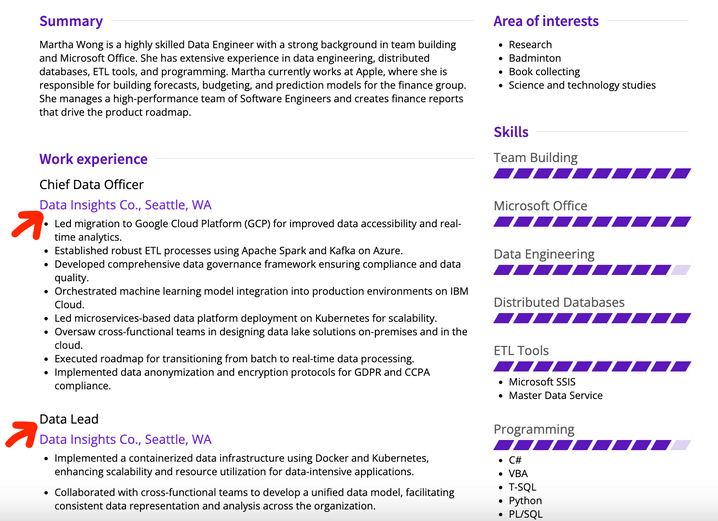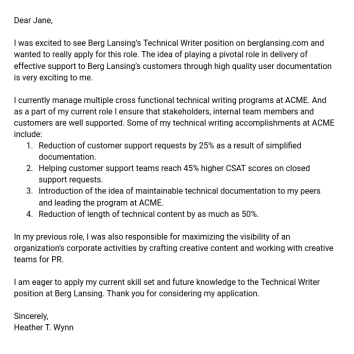
How to Show Promotions on a Resume: Examples, Formatting Tips, and ATS Considerations

Promotions on a resume are a powerful way to showcase your career growth and highlight your achievements. They demonstrate your ability to take on increased responsibilities and succeed in more advanced roles. Including these promotions effectively can make a strong impression on potential employers, showing them that you are capable and driven.
In this guide, we'll cover how to list promotions on your resume, including examples and formatting tips. We'll also discuss how to make your resume ATS-friendly, ensuring that your career progression is clearly communicated and easily understood by both humans and machines.
Why You Should Include Promotions on a Resume
Including promotions on your resume is essential because it demonstrates career growth and increased responsibility. It highlights your ability to take on new challenges and succeed in more advanced roles, which employers find attractive.
Promotions provide clear evidence of your skills and accomplishments, showing that you have been recognized for your contributions. They help to differentiate you from other candidates by showcasing your professional development and commitment to your work.
For example, if you started as an entry-level analyst and moved up to a managerial position, this progression shows your leadership abilities and adaptability. It also indicates that you have gained valuable experience and skills that are crucial for the role you’re applying for.
How to Show Promotions on a Resume
When detailing promotions on your resume, it's essential to choose a method that best showcases your career growth and aligns with the roles you're applying for. Here are additional strategies:
-
Stacked Entries: This method involves listing all the roles you've held at the same company under one company name, stacking the job titles and dates in reverse chronological order. This approach is particularly useful when your roles were similar or when you want to emphasize your tenure and growth within a single organization. For instance:
Company Name, Location Senior Analyst, May 2020 - Present Junior Analyst, June 2018 - May 2020
- Led project management initiatives resulting in a 20% increase in efficiency.
- Promoted for exceptional performance and leadership skills.
-
Separate Entries: This technique is ideal when your roles had significantly different responsibilities or when you returned to a company after working elsewhere. Each position is listed as a distinct entry, allowing you to detail specific achievements and responsibilities for each role. For example:
Company Name, Location Senior Marketing Manager, July 2019 - Present
- Spearheaded the digital marketing overhaul, increasing lead generation by 30%.
Company Name, Location Marketing Specialist, January 2017 - July 2019
- Developed content strategies that boosted web traffic by 25%.
-
Bullet Points for Achievements: Regardless of the format you choose, using bullet points to highlight key achievements is essential. Focus on quantifiable results and specific contributions that demonstrate the impact of your work.
-
Combining Roles When Necessary: If the responsibilities of your previous and current positions are very similar, you can combine them into a single entry. This method helps avoid redundancy and saves space. It can be beneficial if you were promoted in title but your role's core duties remained the same. Clearly indicate the promotion through a concise description.
-
Highlighting Key Skills and Responsibilities: With each promotion, your responsibilities likely increased. Highlight the skills and tasks specific to each position. This differentiation helps employers understand your evolving capabilities and the scope of your experience.
-
Explaining Promotions Through Achievements: When you are promoted, it's often due to specific achievements or projects. Use this opportunity to explain the reason for your promotion by detailing the projects or accomplishments that led to it. This can include leadership roles, significant projects, or any other contributions that set you apart.
-
Use Reverse Chronological Order: Always list your most recent position first. This is the most common and effective format, as it places the most relevant experience upfront, which is critical for keeping the reader's attention.
-
Incorporate Keywords for ATS Compatibility: Ensure your resume includes keywords relevant to your industry and the jobs you're targeting. This is particularly important if you're using separate entries, as it helps your resume get past Applicant Tracking Systems (ATS) and into the hands of hiring managers. Include relevant keywords from the job description to align your experience with the desired qualifications.
-
Visual Clarity and Consistency: Use consistent formatting for dates, job titles, and company names to ensure clarity. This helps hiring managers quickly understand your career trajectory. Use bold or italics sparingly to emphasize key elements without cluttering the resume.
-
Contextualizing Each Promotion: Briefly mention the context or reason for each promotion, such as company restructuring, project success, or leadership recognition. This adds depth to your experience and helps employers see the strategic value you brought to your previous roles.
-
Showcasing Leadership and Initiative: If your promotions involved taking on more leadership or supervisory roles, emphasize these aspects. Detail any team management, project leadership, or decision-making responsibilities to illustrate your capacity for leadership and initiative.
By following these guidelines, you can effectively showcase your career progression and the value you brought to each role, making it clear why you are a strong candidate for the positions you're applying for.
Stacked Entries to Show Promotions: Showing Multiple Roles at the Same Company
Stacked entries are a method of listing multiple roles at the same company under a single heading. This format is effective when the roles are closely related, and you want to emphasize your longevity and progression within the company.
In this format, you list the company name once and stack the job titles and dates in reverse chronological order. This approach highlights your career growth and allows you to show promotions without repeating company details. It also makes it easy for employers to see your career progression and dedication to the organization.
For example, if you started as a Junior Analyst and progressed to Senior Analyst, your resume might list:
Company Name, Location Senior Analyst, May 2020 - Present Junior Analyst, June 2018 - May 2020 This setup demonstrates your upward mobility and steady career advancement within the company.
Separate Entries to Show Promotions: When Responsibilities Differ
Separate entries are ideal when your promotions involve significantly different responsibilities or when you return to a company after working elsewhere. This format allows you to highlight distinct roles and achievements in each position, providing a clearer picture of your diverse skills and experiences.
By listing each position separately, you can provide detailed descriptions of your accomplishments and responsibilities in each role. This approach is especially useful if your promotions included a substantial change in duties or required new skills. It helps employers understand the scope of your experience and the specific contributions you made in each role.
For instance, if you worked as a Marketing Specialist and were later promoted to Marketing Manager, you would list each role separately:
Company Name, Location Marketing Manager, July 2019 - Present
- Led a team to implement new strategies that increased engagement by 40%.
Company Name, Location Marketing Specialist, January 2017 - July 2019
- Developed and executed campaigns that boosted brand awareness.
This method showcases the breadth of your experience and highlights the unique contributions made in each role.
Highlighting Achievements in Each Role While Listing Your Promotion
When listing promotions on your resume, it's crucial to highlight achievements in each role to demonstrate the value you brought to the company. Use specific, quantifiable metrics to showcase your impact, such as increased sales, improved efficiency, or successful projects.
To effectively highlight achievements, use bullet points that start with strong action verbs and include clear outcomes. This approach not only captures attention but also provides concrete evidence of your contributions. Focus on accomplishments that are most relevant to the job you're applying for, tailoring your resume to the specific role and industry.
For example, if you were promoted from Sales Associate to Sales Manager, you could highlight achievements like:
"Increased team sales by 25% in the first quarter as Sales Manager" and "Developed a new customer engagement strategy that boosted repeat business by 15%."
These examples show your progression and the tangible results of your leadership and initiative.
Using Reverse Chronological Order for Listing Promotions
Using reverse chronological order to list promotions on your resume ensures that your most recent and relevant experience is highlighted first. This format places the newest job position at the top, followed by previous roles, providing a clear view of your career progression.
This approach is preferred by recruiters and hiring managers as it allows them to quickly understand your latest and most advanced experiences. It helps to emphasize recent promotions and the responsibilities you've undertaken in your most current role, which are often the most relevant to potential employers.By organizing your resume this way, you make it easier for employers to see your growth and achievements over time.
For example, if you have progressed from a Junior Developer to a Senior Developer and then to a Team Lead, you would list these positions starting with Team Lead at the top, followed by Senior Developer and Junior Developer. This order showcases your upward trajectory and the increasing levels of responsibility you have handled.
How to List Promotions on a Resume and Tackle Addressing ATS Concerns
To effectively list promotions and ensure your resume is ATS-friendly, follow these tips:
- Separate Each Promotion: Clearly list each job title and the dates held, even if at the same company. This helps ATS systems differentiate between roles.
- Use Consistent Formatting: Keep the formatting of company names, job titles, and dates uniform across all entries to maintain clarity.
- Include Relevant Keywords: Use specific keywords related to the skills and responsibilities of each promoted position to align with the job description.
- Focus on Achievements: Highlight significant achievements and responsibilities in each role to show career progression and the impact of each promotion.
- Avoid Complex Formatting: Stick to simple, text-based formatting without graphics or unconventional bullet points, which can disrupt ATS parsing.
These practices help ensure that your promotions are clearly recognized and that your resume is compatible with ATS software, improving the chances of it being reviewed by a recruiter.
How to Explain Short-Term Promotions
When explaining short-term promotions on your resume, it's important to provide context that highlights your achievements and justifies the quick advancement:
- Highlight Accelerated Performance: If the promotion was due to exceptional performance, clearly state this and provide specific achievements that led to the rapid advancement.
- Emphasize Unique Opportunities: Mention if the promotion occurred due to unique opportunities such as a special project or a sudden company need that you fulfilled successfully.
- Detail Leadership Recognition: Explain if the promotion was a result of being recognized by leadership for your skills, adaptability, or contributions that went beyond your role.
- Address Potential Concerns: If the promotion timeline might raise concerns, such as seeming too fast, briefly explain the situation in a cover letter or interview, focusing on your readiness and suitability for the new responsibilities.
- Describe Increased Responsibilities: Highlight any significant increase in responsibilities that justified the promotion, emphasizing your ability to quickly adapt to and excel in more challenging roles.
- Showcase Unique Skill Sets: If your skill set was a rare fit for the new role, mention this as a factor in your promotion, underscoring your unique contributions to the organization.
- Clarify Internal Restructuring: If the promotion was part of an internal restructuring or reorganization, explain how you were selected for the new role, showcasing your qualifications and readiness.
- Indicate External Recognition: If your promotion was influenced by external recognition, such as awards or certifications, include this to highlight your achievements and the value you brought to the organization.
- Mention Mentorship or Sponsorship: If a mentor or sponsor within the company advocated for your promotion due to your potential and performance, mention this support to validate your advancement.
Examples of Well-Formatted Promotion on Resume
When listing promotions on your resume, it's essential to showcase them in a clear and organized manner. Here are some examples of well-formatted promotions:
Example of Stacked Entries to Show Promotion on Resume
Use this format if your roles were similar in nature but showed career progression.
Company Name, Location Senior Financial Analyst, June 2020 - Present Junior Financial Analyst, January 2018 - June 2020
- Developed comprehensive financial models that improved forecasting accuracy by 15%.
- Promoted due to consistent top performance and leadership in key projects.
Formatting Promotion on Resume with Separate Entries
Ideal for significantly different roles or responsibilities, each role is listed separately.
Company Name, Location Marketing Manager, July 2021 - Present
- Led a rebranding campaign that increased market share by 20%.
- Managed a team of 10 marketing specialists.
Company Name, Location Marketing Specialist, March 2019 - July 2021
- Implemented digital marketing strategies that doubled online engagement.
- Recognized for innovative approaches to content marketing.
Formatting Promotion on Resume with Bullet Point Achievements
Highlight specific achievements that led to promotions.
Company Name, Location Project Manager, August 2019 - Present
- Promoted after successfully managing a $1M project, delivering it on time and under budget.
- Introduced a new project management methodology that increased efficiency by 30%.
Formatting Promotion on Resume in a Reverse Chronological Order
Use this format to list your most recent and relevant roles first.
Company Name, Location Director of Sales, May 2022 - Present
- Oversaw a 25% increase in annual sales through strategic market expansion.
Company Name, Location Sales Manager, January 2020 - May 2022
- Led a team to achieve the highest sales growth in the company’s history.
Formatting Promotion on Resume by Highlighting Key Skills
Emphasize the skills and responsibilities associated with each promotion.
Company Name, Location IT Manager, October 2020 - Present
- Promoted for demonstrating leadership in crisis management during a major system upgrade.
- Managed a cross-functional team to enhance cybersecurity protocols.
Formatting Promotion on Resume By Showcasing Project-Based Promotions
If your promotion was tied to specific projects, highlight the key projects and outcomes.
Company Name, Location Senior Project Coordinator, January 2021 - Present
- Promoted after successfully leading a major software implementation project, improving operational efficiency by 40%.
- Coordinated cross-departmental teams to achieve project goals on time.
Formatting Promotion on Resume by Highlighting Return to Previous Company
If you returned to a previous company in a higher role, detail both stints to show growth.
Company Name, Location Senior Account Executive, February 2023 - Present
- Rehired to lead a new sales team, significantly increasing client acquisition.
- Managed key accounts and developed new client strategies.
Company Name, Location Account Executive, June 2018 - December 2020
- Consistently exceeded sales targets, leading to the development of new sales initiatives.
Formatting Promotion on Resume by Showcasing Horizontal Moves with Promotions
If your promotions involved lateral moves with increased responsibilities, clarify the transition.
Company Name, Location Senior Content Strategist, April 2021 - Present
- Transitioned from Editorial Team Lead to focus on content strategy, overseeing content for major brand campaigns.
- Developed and implemented a content strategy that boosted brand visibility.
Formatting Promotion on Resume by Showcasing Multiple Promotions in a Short Time Frame
When multiple promotions occurred within a short period, clearly list each with distinct achievements.
Company Name, Location Operations Director, January 2022 - Present
- Promoted twice within two years for driving operational improvements and cost savings initiatives.
- Led a team to streamline processes, reducing operational costs by 20%.
These examples demonstrate how to effectively showcase promotions, ensuring your career progression is clear and compelling to potential employers.
Common Mistakes to Avoid When Listing Promotions
When listing promotions on your resume, avoid these common mistakes to ensure your experience is presented clearly and professionally:
- Lack of Clarity: Failing to separate different roles can confuse readers. For example, instead of writing "Marketing Manager/ Specialist," list each title with distinct responsibilities and dates. This approach clarifies your career progression.
- Inconsistent Formatting: Using varied formats for job titles, dates, and company names can make your resume look unorganized. For instance, consistently format job titles in bold and dates in italics to maintain a professional appearance.
- Overloading with Information: Including too much detail in each role can overwhelm the reader. Focus on key achievements, like "Increased sales by 20%," which are relevant to the job you are applying for.
- Ignoring Chronology: Listing roles out of chronological order can confuse employers about your career progression. Always list your most recent position first to clearly show your career trajectory. For example, start with "Sales Director, 2021 - Present" before listing "Sales Manager, 2018 - 2021."
- Not Explaining Short-Term Promotions: Failing to provide context for short-term promotions can raise questions. Briefly explain the reasons for rapid advancements, such as "Promoted to Senior Analyst within six months due to outstanding performance."
By avoiding these mistakes and providing clear, well-organized information, you can present a compelling narrative of your career progression and achievements.
The Importance of Including Dates of Employment while Listing Promotions on a Resume
Including dates of employment on your resume is vital as it establishes a clear timeline of your career progression. This helps employers understand how long you held each position, reflecting your stability and commitment.
Specific dates are crucial for showcasing your promotions. They highlight the frequency and timing of your career advancements, making your growth visible. Clear dates also ensure compatibility with Applicant Tracking Systems (ATS), enhancing your resume's readability and chances of passing initial screenings.
- Why You Should Include Promotions on a Resume
- How to Show Promotions on a Resume
- Stacked Entries to Show Promotions: Showing Multiple Roles at the Same Company
- Separate Entries to Show Promotions: When Responsibilities Differ
- Highlighting Achievements in Each Role While Listing Your Promotion
- Using Reverse Chronological Order for Listing Promotions
- How to List Promotions on a Resume and Tackle Addressing ATS Concerns
- How to Explain Short-Term Promotions
- Examples of Well-Formatted Promotion on Resume
- Common Mistakes to Avoid When Listing Promotions
- The Importance of Including Dates of Employment while Listing Promotions on a Resume

Written By
Madison Norton
VP Marketing & Resume Expert
Madison is the VP Marketing and General Manager at VisualCV. He's a seasoned marketing leader, resume writing and career marketing expert and now helping people grow their own career marketing strategies to build a career they love.

Learn how to write a targeted resume that matches job descriptions with precision. Discover tips on customizing your resume using keywords, optimizing for ATS, and highlighting relevant skills and experiences to improve your job application success.
July 19, 2024
Read Post

VP Marketing & Resume Expert

Learn how to write a compelling cover letter with ChatGPT. Explore 20+ prompt examples to customize your cover letter for any job application. Enhance your chances with tailored, professional cover letter prompts and tips inside.
July 19, 2024
Read Post

VP Marketing & Resume Expert

Resume formatting tips and examples for all jobs and experience levels. Learn how to best format your resume and land that dream job in 2025!
February 4, 2025
Read Post

VP Marketing & Resume Expert
Copyright ©2025 Workstory Inc.